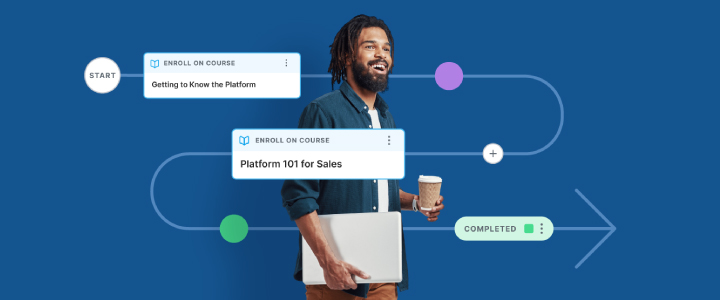
4 min reading time
7 Simple Steps to Write Targeted Learning Objectives
The purpose of implementing an online training strategy is to achieve the learning objectives and impart practical knowledge. Can you write targeted learning objectives that will help you determine whether your corporate learners have actually benefited from your online training course?
A Step-By-Step Guide to Writing Learning Objectives
Learning objectives are a remarkably simple way of proving the efficacy of your online training courses. The catch is that you have to define your learning objectives clearly, both for your employees and your organization as a whole, before you create your training programs. And for them to be effective they have to be direct. Here’s a 7-step guide to creating targeted learning objectives.
Step 1: Conduct training needs analysis
The goal of a learning objective is to target gaps that hinder workplace productivity or hurt your bottom line. For example, employees are unable to complete a work-related task, which prevents them from meeting customers’ expectations. So, you must conduct a training needs analysis to get to the root of the problem and create relevant learning objectives. This may involve observations, LMS reports, and online assessments that identify issues and allow you to develop more succinct statements.
Step 2: Get employee input
Employees can shed light on areas of your online training programs that may be falling short. This allows you to reevaluate objective statements that pertain to these weak spots. Another benefit of gathering employee feedback is that you can discover personal areas for improvement that were previously undisclosed. For example, corporate learners may lack a specific skill they need to complete a task. To address this, you can develop secondary learning objectives that focus on the ‘building blocks’ of task performance.
Step 3: Distinguish between training goals and learning objectives
In everyday language, the words target, goal, and objective are used as synonyms. However, in a learning setting, like an online training event, there’s some slight differences. Goals are more broad and general. Your online training goal could be to ‘improve on-the-job performance.’ Learning objectives need to be more detailed.
If they’re not, there’s no real way of confirming you’ve achieved them. It’s also important to note that you can break more detailed learning objectives into manageable short-term goals. This improves learner motivation and allows them to track their progress along the way.
Step 4: Pick a knowledge level
Bloom’s Taxonomy was developed in 1956, and it’s still applicable today. Benjamin Bloom, the educational psychologist who created this system, divided learning into six stages.
- Knowledge: recall, memorize, recite
- Comprehension: understand, interpret, explain, compare, translate
- Application: use in a practical scenario, demonstrate
- Analysis: deeper exploration to discover ‘how’ and ‘why’
- Synthesis: deeper application to sense patterns and develop new ideas
- Evaluation: case studies and review
Look at your online training materials and identify which stage each module falls under. This will help you frame the right language for your learning objectives.
Step 5: Name your concept
They say names have power. At the doctor’s office, you have to describe your condition to the doctor using nouns, not adjectives. It makes issues easier to diagnose and resolve. Similarly, you need a name for your learning objectives. Start with a noun. Look at your online training materials and point out the primary topic. Examples include rules, language, grammar, office policies, and so on. Identify exactly what it is you want your corporate learners to learn, and name it using two or three nouns.
Step 6: Select a measurable verb
The verb you choose has to be particular enough to judge and evaluate. For instance, you can’t be sure someone has ‘understood’ a concept. But you can clearly tell whether they can ‘list/identify/illustrate/calculate’ a given concept. Choose verbs that are measurable. The learning stage will guide your verb choice. You should also ensure that the verb is understandable for corporate learners. Avoid technical jargon that employees aren’t able to fully comprehend.
Step 7: Check for viability
Writing a learning objective isn’t a finite task. If corporate learners can’t achieve your stated target, then it’s just a bunch of pretty words. And sometimes, their inability has nothing to do with their, lack of, effort or skills. They might be unable to reach the target because it was badly formulated and is, therefore, not achievable. Your learning objective should be:
- Specific: direct, not vague or generalized
- Measurable: it can be tested, observed, and evaluated in a practical way
- Achievable: corporate learners and instructors can clearly say ‘Yes, they did it,’ or ‘No, they didn’t’
- Rewarding: corporate learners have to be motivated to aim for the target
- Timely: it has a reasonable time frame that is clearly mentioned
Checking for viability also involves fine-tuning learning objectives after you’ve launched the online training course. You should evaluate LMS metricsand conduct surveys to determine if learning objectives are clear and align with your corporate learners’ needs. You may have to modify the wording or expand on the criteria to measure learner performance more effectively. Writing targeted learning objectives is the best way to assess your online training program. Online assessments and quizzes primarily show your corporate learners can retain information. Learning objectives show that corporate learners have acquired knowledge they can apply to their work and life.
However, if you fail to create targeted statements, your corporate learners can’t achieve them or clarify expectations. They don’t know your definition of success or how to fulfill the job requirements. Separate your learning objectives from your online training goals, and class them in the right phase of Bloom’s Taxonomy. Pick the right noun and verb for your learning objective. Then write it out and test it for specificity, measurability, achievability, reward, and timeliness. When deploying eLearning courses for adult learners, you should expect some bumps in the road. Read the article eLearning For Adult Learners: 6 Obstacles To Overcome to discover the pitfalls to avoid when creating eLearning for adult learners.
This guest post was written by Christopher Pappas, Founder of The eLearning Industry’s Network, which is the largest online community of professionals involved in the eLearning field. Christopher holds an MBA and an M.Ed. (Learning Design) from BGSU.



